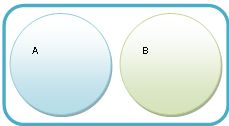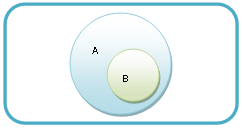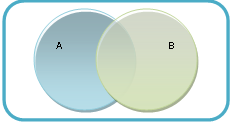Indicated Assent
What is this Tutorial About?
The tutorial entitled Introduction to Classical Logic introduced the fact that ideas at the mental level are divided into تصور (concept) and تصديق (assent) and the tutorial entitled Indication explained that these ideas can be realized in many ways, including coined speech. When an idea is realized, the extra-mental realization is termed the دال (indicator) and the idea in the mind on which it indicates is termed the مدلول.
The tutorial entitled Simple Indication dealt with the دال for concepts while the tutorial Indicated Concept dealt with the مدلول in order to facilitate the first oasis of Classical Logic, the study of Definitions.
Similarly, Compound Indication dealt with the دال for assent. And now this tutorial is designed to deal with the مدلول for assent in order to facilitate the other oasis of Classical Logic, the study of proofs. In discussing the مدلول for assent, we visit two main concepts: the opposite of an assent, and the inverse. It is a good idea for one to read the tutorial entitled Modern Logic in order to benefit fully from some of the topics contained herein.
Opposite
Basic Statements
The opposite or contradiction (نقيض) of a statement is another statement that is true whenever the first is false and false whenever the first is true. For example, consider the statement “Zaid is human.” The opposite of this is the statement “Zaid is not human.” Notice that in order to achieve the opposite of a statement, we simply flip the affirmativeness of the sentential copula. Achieving opposition by doing anything else is invalid; for example, the opposite of the above example cannot be achieved by saying “Zaid is inhuman” because, although it makes sense for this particular statement, this method may not always yield the desired effect.
A statement is a نقيض for another statement if the affirmativeness of both is opposite. But the two statements must match in all other aspects. If there is a mismatch in even one of the aspects, the statements are not considered contradictory. For example, “Zaid is Amr’s father” and “Zaid is not Bakr’s father” are not opposites/contradictions because they don’t match in one of the aspects.
Eight aspects have been identified in which two statements must match in order to be considered contradictory. They are listed in the table below with examples. But remember, the two statements must match in all aspects; the list below is just an attempt to try and expose these and it may be found to be incomplete.
Aspect | Example | Counterexample |
Subject | Zaid is sitting | Zaid is sitting |
Predicate | Zaid is sitting | Zaid is sitting |
Place | Zaid is present in the house | Zaid is present in the house |
Time | Zaid is sleeping during the night | Zaid is sleeping during the night |
Condition | Zaid is a writer while he is writing | Zaid is a writer while he is writing |
Potential/actual | The wine can be intoxicating | The wine can be intoxicating |
Part/whole | The kangaroo is strong; i.e. its legs | The kangaroo is strong; i.e. its legs |
Relationship | Zaid is a father to Amr | Zaid is a father to Amr |
Quantified Statements
If a statement is quantified, we can use the rules studied in Modern Logic to help us in forming the contradiction. These rules can also be used to help us validate whether two statements are contradictory or not. Consider the example “all dogs are playful.” Recall that in order to negate a quantified statement like this, we start by applying the negation to the entire statement and we then move it into the scope of each applicable quantifier.
¬∀d Playful(d) | it is not the case that all dogs are playful | |
⇒ | ∃d ¬Playful(d) | there are some dogs that are not playful |
Sometimes a statement can be negated without flipping the quantifier. But that is not always the case. Moving the negation into the scope of a quantifier and flipping that quantifier guarantees contradiction. And that is what we want; a sure-fire way to form the contradiction of any statement.
Moderated & Temporal Statements
Recall the various modalities studied in Compound Indication. Each modality can be expressed as a combination of necessity and possibility, plus negation. In other words, we want to take all the modalities we’ve learned and categorize them as one of necessity or possibility with the option of being able to negate a statement.
Necessity is represented symbolically as □ and possibility as ◇. These act very similar to the quantifiers ∀ (all) and ∃ (some) except that □ (necessarily) and ◇ (possibly) are modalities and not quantifiers. A simple example follows.
◇(∀h ¬SunShine(h))
It is possible that the sun is not shining for all hours of the day
The symbols □ and ◇ are also used in temporal logic, where □ means ‘always’ and ◇ represents ‘sometimes’. An example follows.
□ (∀h ¬SunShine(h))
It is always the case that the sun is not shining for all hours of the day
Negating these modalities is done in exactly the same manner as negating the quantifiers. We start by placing the negation at the very front of the moderated proposition, and we then bring it into the scope of each relevant modality, flipping the modality as the negation passes over it. An example follows where we are trying to contradict the statement “sunshine is necessarily there.”
¬□SunShine | it is not the case that sunshine is necessarily there | |
⇒ | ◇¬SunShine | it is possible that sunshine is not there |
And here’s another example where we use both modalities and quantifiers together. Here we are trying to contradict the statement “it is necessarily the case that all students will pass.”
¬□(∀s Pass(s)) | it is not necessarily true that all students will pass | |
⇒ | ◇¬ (∀s Pass(s)) | it’s possible that it is not the case that all students will pass |
⇒ | ◇ (∃s ¬Pass(s)) | it’s possible that some students won’t pass |
Again, it is often possible to achieve the contradiction of a moderated statement by negating the proposition but leaving the modality. However, this does not ensure a sure-fire way of achieving the opposite and we thus consider it invalid. For example, the following two statements are contradictory: “it is necessarily true that all dogs are playful” and “it is necessarily true that all dogs are not playful.” But these two are not: “it is possible that all dogs are playful” and “it is possible that all dogs are not playful”; notice that both statements are true.
Compound Statements
We can use the above rules to achieve the opposite of a single clause whether it be simple, quantified, moderated, or quantified and moderated. But we can also use the equivalence rules studied in Modern Logic to find the opposite of compound statements – that is, two or more statements connected together using logical connectives such as AND, OR, IF-THEN, etc. The example below illustrates this. We are trying to oppose the following statement.
∃h (S(h) ∧ R(h)) → ◇ (∀p G(p))
If there is an hour (during the day) such that the sun is shining and it is raining
then it’s possible that everybody found the pot of gold
¬(∃h (S(h) ∧ R(h)) → ◇ (∀p G(p))) | |
⇒ | ¬(¬(∃h (S(h)
∧ R(h))) ∨ ◇ (∀p G(p))) |
⇒ | ∃h (S(h) ∧ R(h)) ∧¬◇ (∀p G(p)) |
⇒ | ∃h (S(h) ∧ R(h)) ∧□ (¬∀p G(p)) |
⇒ | ∃h (S(h) ∧ R(h)) ∧□ (∃p ¬G(p)) |
∃h (S(h) ∧ R(h)) ∧□ (∃p ¬G(p))
There is an hour such that the sun is shining and it is raining,
and (yet) there are necessarily some people that didn’t find the gold
Inverse
Quantified Statements
The inverse (عكس مستوي) of a statement is another statement in which the subject and predicate have been swapped. The goal of inversion is to swap the subject and predicate while assuredly maintaining the truth value of the statement. And in order to assuredly maintain the truth value, we have control over the quantifier of the statement. Take, for instance, “all humans are animals.” The inverse is achieved by swapping the subject and predicate to obtain “all animals are humans.” However, the inverted statement is false while the original is true. In order to maintain the truth, we need to modify the quantifier in the inverse to achieve “some animals are human.” And there we have it.
Consequently, notice that inversion applies to statements that are quantified; it does not make sense to invert non-quantified statements. The table below outlines the inverses for quantified statements.
Original | Inverts To | Example (original) | Example (inverse) |
affirmative universal | affirmative existential | all humans are animals | some animals are human |
negative universal | negative universal | no human is rock | no rock is human |
affirmative existential | affirmative existential | some animals are human | some humans are animals |
negative existential | (none) |
To show that these inverses are indeed accurate, and to get a better sense of the relationship between two universals and the relationship between their opposites, let’s consider the Venn Diagrams.
 | Disjoint Sets: From
the diagram, we are free to say that no A is B and that no B is A. This helps
show that the inverse of a negative universal is a negative universal. Let’s take this opportunity to consider the opposites of A and B. The
opposite of A includes B and more. And the opposite of B includes A and more.
Thus the opposites of disjoint sets are overlapping sets. |
 | Equal Sets: We can
say from the diagram that all of A is B and all of B is A. But this does not
mean that the inverse of an affirmative universal is an affirmative
universal. That is only true in the case of equal sets; see Included Sets
below. Let’s consider opposites. As it turns out, the opposite of A and the
opposite of B are one and the same. Thus the opposites of equal sets are also
equal sets. |
 | Included Sets: We
can say that all of B is A and that some of A is B. Putting this information
together with the case of Equal Sets, we can conclude that the inverse of an
affirmative universal is an affirmative existential. Considering opposites, we notice that the opposite of A includes none
of B, and the opposite of B includes some of what the opposite of A included,
but some of A itself as well. Therefore, we can conclude that the opposites
of two included sets are two included
sets. |
 | Overlapping Sets: Clearly,
some of A is B and some of B is A. Therefore, the inverse of an affirmative
existential is an affirmative existential. We might be inclined to conclude
also that some of A is not B and some of B is not A. Although this is true
for Overlapping Sets, recall Included Sets. There, we can say that some of A
is not B, but we cannot say that some of B is not A (for, indeed, all of B is
A). Therefore, we can make no conclusions about the inverse of a negative
existential. Considering opposites, we see that the opposite of A includes some of
B and more. And the opposite of B includes some of A and more. Thus the
opposites of two overlapping sets are two overlapping sets. |
Moderated Statements
This is a somewhat complicated discussion. Before beginning, the reader should thoroughly understand the nine basic (non-compound) modalities in Logic. These can be recalled from Compound Indication and have been briefly reproduced below in a minimalist manner. We will not discuss here the compound modalities because of their lack of fruitfulness.
Explanation | Arabic Term | |||
possible | الممكنة | 1 | ||
Necessary | الضرورية | |||
unconditionally
or as long as the subject exists | الضرورية
المطلقة | 2 | ||
so
long as the subject is attributed with the quality that it bears (e.g.
writer-ship for ‘writer’); the quality is constitutive | المشروطة
العامة | 3 | ||
during
a specified timeframe | الوقتية
المطلقة | 4 | ||
during
some unspecified timeframe | المنتشرة
المطلقة | 5 | ||
Not
necessary, but perpetual | الدائمة
| |||
unconditionally | الدائمة
المطلقة | 6 | ||
so
long as the subject is attributed with the quality that it bears (e.g.
writer-ship for ‘writer’); the quality is NON-constitutive | العرفية
العامة | 7 | ||
The way in which we will approach this is to consider affirmative and negative universals and existential, and for each of these, consider the various modalities. The chart below illustrates the breakdown. Some combinations, however, do not yield inverses; those have been marked with (none) in the chart.
Note: when we say negative universal, for instance, we mean that the quantifier is universal and the negation is being applied within the scope of the quantifier. In other words, we mean ∀a ¬B(a), instead of¬∀a B(a).
Original | Inverse | ||
Quantifier | Affirmativeness | Modality | |
Universal | Affirmative | 1 | (none) |
2 | Existential Affirmative حينية
مطلقة | ||
3 | Existential Affirmative حينية
مطلقة | ||
4 | (none) | ||
5 | (none) | ||
6 | Existential Affirmative حينية
مطلقة | ||
7 | Existential Affirmative حينية
مطلقة | ||
Negative | 1 | (none) | |
2 | Universal Negative 6 | ||
3 | Universal Negative 7 | ||
4 | (none) | ||
5 | (none) | ||
6 | Universal Negative 6 | ||
7 | Universal Negative 7 | ||
Existential | Affirmative | 1 | (none) |
2 | (none) | ||
3 | (none) | ||
4 | Existential Affirmative مطلقة
عامة | ||
5 | (none) | ||
6 | (none) | ||
7 | (none) | ||
Negative | 1 – 7 | (none) | |
Let’s consider the existent inverses one by one. The inverse of both a Necessary Universal Negative and a Perpetually Universal Negative is a Perpetually Universal Negative. For example, the inverse of “no human is rock, necessarily” is “no rock is human, perpetually.”
We’ve already learned that to achieve the inverse of a Universal Negative we need another Universal Negative. But it is not clear why we need to change Necessarily to Perpetually. In other words, why is it that when something is necessarily true, its inverse is only perpetually true? Well, if the inverse “no rock is human, perpetually” is not true, then its contradiction must be true: “some rocks are human, actually.” So we have that “some rocks are human, actually” and “no human is rock, necessarily;” therefore, we have that “some rocks are not rocks, actually”. Thus we have a contradiction, and so the inverse of a Necessary Universal Negative cannot be a Necessary Universal Negative.
Moving on, the inverse of both a Universal Negative Modality-3 and a Universal Negative Modality-7 is a Universal Negative Modality-7. For example, consider the statements “nothing that is A is B, necessarily insofar as it is A” and “nothing that is A is B, perpetually insofar as it is A.” The inverse of both of these is “nothing that is B is A, perpetually insofar as it is B.”
Again; why is it that the inverse of a Universal Negative Modality-3 is a Universal Negative Modality-7? In other words, why is it that the inverse of a statement whose truth is subject to a constitutive attribute is a statement whose truth is subject to a non-constitutive attribute? Or, put differently, why is it that the inverse of a statement that is necessarily true so long as something holds is a statement that is only perpetually true so long something (else) holds?
To answer this, consider “no blinker can see, necessarily insofar as he is blinking.” Not only is this true, but it is necessarily true because a blinker, in his capacity as a blinker, necessarily has his eyes closed; that is part of the definition of blinking. Now let’s assume that the inverse of this is “no one that can see blinks, necessarily insofar as he is seeing.” But wait a minute. Yes; it is true that since no blinker can see, no seer is blinking. But just because not seeing was necessary for blinking doesn’t mean not blinking is necessary for seeing. Of course a seer is not blinking, but that is accidental and has nothing to do with the definition of seeing.
The inverse for Universal Affirmative Necessary, Universal Affirmative Perpetual, Universal Affirmative Modality-3, and Universal Affirmative Modoality-7 is Existential Affirmative حينية مطلقة. Let’s consider the following examples.
1.
Universal Affirmative Necessary:
all humans are animals, necessarily
2.
Universal Affirmative
Perpetual:
all humans stand upright, incidentally
3.
Universal Affirmative
Modality-3:
all things that move change, necessarily as long as they are moving
4.
Universal Affirmative
Modoality-7
all writers move their fingers, incidentally as long as they are writing
All of these invert to an Existential Affirmative حينية مطلقة. A حينية مطلقة is a modality that stipulates the application of a predicate to a subject in actual sense (i.e. it actually has, is, or will happen) as long as the subject is what it is. For example, “some clouds come down to our elevation, actually but only in their capacity as clouds (if it rains, we do not say that clouds are coming down).”
Let’s consider the inverses of each of the above examples in turn.
1. some animals are human, actually and in their capacity as animals
2. some of those things that stand upright are humans, actually and as long as they are standing upright
3. some things that change move, actually and as long as they are changing
4. some of those things that move their fingers are writers, actually and as long as they are moving their fingers
Finally, an Existential Affirmative Modality-4 inverts to an Existential Affirmative مطلقة عامة. A مطلقة عامة is a modality that stipulates that a predicate has, is or will apply to a subject in actual fact. An example of an Existential Affirmative Modality-4 is “all moons are blocked from sunlight, during their eclipse.” And this inverts to “some of those things that are blocked from sunlight are moons, actually at some point in time.”
Compound Statements
The only type of compound statement for which inversion is discussed are conditionals. And, as with non-compound statements, these must also be quantified; they must either be universal (whenever) or existential (sometimes). What it means to invert a quantified conditional statement is to make the protasis the apodosis and vice versa. For example, “whenever A is B, C is D” inverts to “sometimes when C is D, A is B.”
The inversions of conditional statements have been summarized in the chart below.
Affirmative | Negative | |
Universal | (1) affirmative existential | (2) negative universal |
Existential | (3) affirmative existential | (4) (none) |
1.
Original: whenever A is B,
C is D
Inverse: sometimes when C is D, A is B
2.
Original: never is it that
when A is B, C is D
Inverse: never is it that when C is D, A is B
3.
Original: sometimes when A
is B, C is D
Inverse: sometimes when C is D, A is B
The above inverses are quite easily verified and understood. However, it should be noted that an Existential Negative has no inverse. That is to say, we have no assured way of inverting a statement like “sometimes it is not the case that when A is B, C is D.” For we cannot claim anything with certitude about C being D when A is B.
Inverse by Contrapositive
There is another type of inverse known as Inverse by Contrapositive (عكس النقيض). It involves inverting the converses of the subject and predicate in a manner somewhat like the above. For example, the contrapositive inverse of “no human is rock” is “some non-rocks are non-humans.” This topic, however, is an older method of achieving inversion and its benefits are limited. Therefore, we will not pursue this topic here. If one does wish to delve into this, one is encouraged to use the principles studied in this tutorial along with the aid of Venn Diagrams to extrapolate the contrapositive inverses.